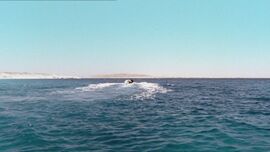| Ordovician | |||||||||||
|---|---|---|---|---|---|---|---|---|---|---|---|

| |||||||||||
| Previous period Cambrian |
Following period Silurian | ||||||||||
The Ordovician (named after the Ordovices, an ancient Celtic tribe who inhabited Central Wales before the Roman invasion of Britain in 43 AD) was a period in Earth's history. Although nearly all of life in Ordovician was underwater, some arthropods like the eurypterids ventured onto land, mainly to mate.
Ordovician atmosphere was unlike today's air. There was much more carbon dioxide present in the atmosphere back then than today. If a human visited the Ordovician without special breathing apparatus, they would experience headaches and nausea.
Environments and ecology[]
Life in the Ordovician was still mainly situated in the seas, which were home to many primitive corals and marine animals. However, the most populous creatures in the Ordovician seas were the arthropods.
Some of the most numerous arthropods were the trilobites which grew to many different shapes and sizes. The Ordovician saw the evolution of the chelicerates, a group of arthropods that include modern arachnids. One specific group of chelicerates - the eurypterids - were very common and could haul themselves onto dry land for brief periods of time. The land was barren, apart from the few different types of smile moulds and lichen that lived along the banks of streams.
In the ocean abyss, the giant orthocone Cameroceras, an ancient relative of squids, was the first truly gigantic predator. Meanwhile, the vertebrates were represented by the detritivorous jawless fish that lived on the seabed.
In Sea Monsters[]
Dangerous Seas[]
Nigel Marven traveled back to the Ordovician to visit the seventh deadliest sea ever. There, he was attacked and injured by a Megalograptus.
The next day, using an Isotelus trilobite as bait, Nigel found a Cameroceras and following that, he left the Ordovician to visit the next deadliest sea - the Triassic.
Creatures[]
List of appearances[]
- The Complete Guide to Prehistoric Life
- Sea Monsters - Dangerous Seas
- Sea Monsters: Prehistoric Predators of the Deep
